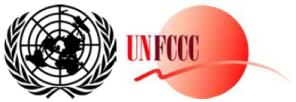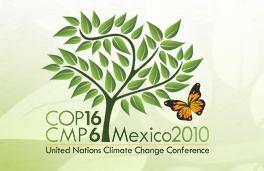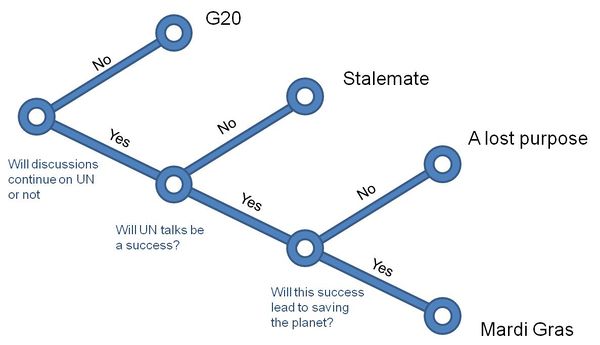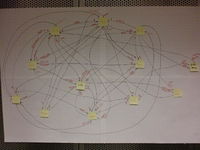Climate Change Negotiations
Group Members
Bastian Wollenschein
Rohit Patnekar
Sergey Kharebov
Ling-Chin Fan
Rachit Tayal
Numbers That Matter Presentation
Introduction
Climate forms a very critical part of the ecosystem that sustains life on earth and it is changing rapidly due to human activity. Almost every strategic decision today is in some way dependent on how the climate change would evolve in coming years. Although the extent of change and its consequences are being investigated by scientist, the action lies within the jurisdiction of the national governments and any success depends on their collaboration and leadership. The United Nations Framework Convention on Climate Change (UNFCCC) is the joint treaty that looks into the aspect of reducing green house gases by emission reduction and ensuring economic growth in tandem. Despite major efforts from several nations no concrete steps in emission reductions have emerged till now, the future of these negotiations is critical to rationally understand the uncertainties involved and thereafter devise a strategy that fits all probably futures.
Hence, on this page we explore the different possibilities for the climate change negotiation by asking: �How would the climate change negotiations evolve in the coming 10 years?�
Therefore, this scenario set explores the different pathways that negotiations on Climate change will take in the next 10 years.
The Focal Issue
How would the climate change negotiations evolve in the coming 10 years?
Scenario Tree
Scenario Stories
The following are the four scenario stories detailing different futures for climate change negotiations in 2020:
- Deadlock among stake holders
- Multilateral Agreement through G20
- Negotiations succeed but earth dies
- Negotiations succeed & earth survives
Stakeholder Analysis
Countries
1. US
2. EU
3. China
4. India
5. Brazil
6. Russia
7. South Africa
8. OPEC
9. Island Nations
10. Japan
Other Stake Holders
1. IPCC
2. NGOs
3. Media
4. Lobbyists
System diagram
Separate subsystems for the main negotiations participants could be found under the Countries section above
Questions to research
The negotiation process
1. What is a current state of negotiations process?
2.Why the negotiations are necessary and so important?
3. How the negotiations are being pursued by different parties and who are the major parties trying to slow down the proccess?
4. How does the negotiation proccess work?
5. Could an agreement upon GHG reduction be reached outside of the UN (UNFCCC)? (I.e. within the context of another group of countries.)
6. Who are the members of a team representing a country at these negotiations?
Stakeholder in the negotiations
7. What is the position of the Netherlands in climate negotiations and how is the country affected by climatic change?
8. What is the position of oil producing countries in the negotiations?
9. Role of corporations in the negotiations?
10. Role of media?
11. Who will drive this more going forward?
12. In EU climate change organization, do you have negotiations between members?
13. Who has better relationship with Netherlands in climate change negotiation aspect?
Events as driving forces
14. Did the recent finance crisis affect the climate change negotiations?
15. What other topics could switch public focus from climate change issue?
16. What kind of numbers are the negotiations target?
17. What is the role of technology?
Independent questions
18. Is there a real evidence of climate change happening?
19. Is the gap between government policy and negotiation target/result huge?
20. Is there any risk for climate change negotiation?
Driving forces
Environmental Driving Forces
1. Greenhouse gas increase
2. Catastrophes - Acts of God
Political Driving Forces
1. Expiration of Kyoto protocol
2. Increasing Commitment from China
3. Increasing involvement of US
4. Increasing involvement of developing nations
Societal Driving Forces
1. Urbanisation
2. Increasing influence of media
3. Initiative from cities
4. Dynamics of Public Support
Economic Driving Forces
1. Carbon Trading, Finances and related Economics
2. Position of Corporates
3. Bilateral Trade
4. Oil Supply and Demand Dynamics
Technological Driving Forces
1. Advancement in Nuclear Power Generation
2. Development of Cheaper & Efficient Solar Panels
3. Development of Alternate Energy Sources
Useful sources
Books
-Daniel Erasmus, The future of ICT in financial services, DTN Press, Amsterdam, 2008
Webpages organizations
-United Nations Framework Convention on Climate Change
-Kyoto Protocol
-Intergovernmental Panel on Climate Change
-IPCC 4th assessment report
-Summary for Policy Makers
-ERIM SCR from RSM
Articles and protocols
-Post-2012 Climate Policy Scenario
-Netherlands
-Annual European Community greenhouse gas
inventory 1990�2007 and inventory report 2009[1]
-Climate change except by region or country, by IEA
-Post Copenhagen from a geopolitical perspective
-The AWG-LCA n�11 from Aug 2010[2]
-Summary of the above [3]
-EU Commission on trade with China
-[4]
-Attack_on_Iraq
-Operation Enduring Freedom
-War in Afghanistan
-[5]
-[6]
-[7]
-UNFCCC
-IPCC
-Urbanization
Videos
-James Hanson to DTN (confidential therefore not published)
-Smith, Martin; Heat from the U.S.
-Meet the BINGOs
-The Carbon Market Lobby
-The Oil and Coal Lobbies
-The Agriculture Lobby
-The Electricity and Gas Lobbies
-The Alternative Energy Lobby
-Hans Rosling on China
-Hans Rosling on urbanization
Data and graphs
-Carbon history
-Carbon emissions
-Co2 increase
-GHG trends
-GHG trends according to UNFCCC
-List of natural disasters



